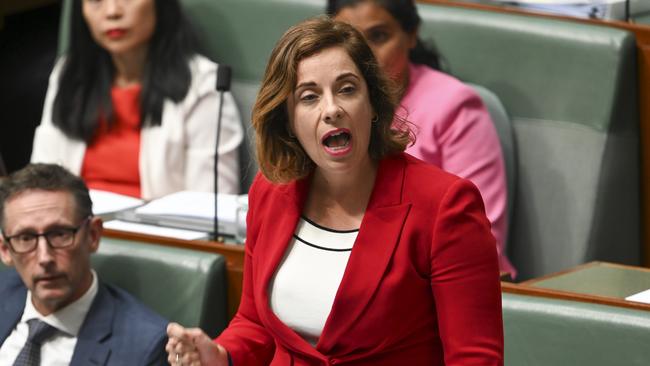Radical new blueprint for aged care reform unveiled
Wealthy seniors, many with big super balances, will be asked to pay more if the recommendations of a task force led by the Aged Care Minister are accepted.

Wealthy older Australians, many with burgeoning super balances, will be asked to stump up more money to fund their aged care if the Albanese government accepts the recommendations of a key task force led by Aged Care Minister Anika Wells.
The radical blueprint for aged care reform would lead to richer older Australians in nursing homes paying more for their rooms, their meals and their everyday living costs. So too for those receiving in-home care, with a greater user-pays component proposed for services such as cleaning and gardening.
The task force recommends the government prioritise in-home care, in line with the expectations of older Australians to remain in their homes as long as possible, with services delivered to them.
It said the government should look after the direct personal care costs being racked up by this older and increasingly frail population, but individuals with means shouldn’t be able to hoard their money to pass on as inheritance.
“Government funding will focus on ensuring all older people can access the care they need, while co-contributions will be required for the things people have typically paid for their whole lives, such as daily living expenses and, for those in residential care, accommodation costs,” the task force report says.
While it doesn’t specifically recommend personal superannuation must cover the costs of aged care, it outlines the benefits of home equity and super to pay for better quality care.
“The task force notes that encouraging older people to access their wealth, including superannuation and home equity release when appropriate, will enable them to make contributions for services to enjoy a dignified retirement experience in aged care,” it said. “Over the next 20 years the number of people with superannuation balances at age 85 will grow considerably, with a greater proportion of people having significant funds available.”
Ms Wells released the findings of the task force on Monday after bringing together industry experts last June to come up with recommendations to make aged care financially sustainable.
The recommendation to press for more user-pays won’t alleviate federal budget pressures though, as the task force notes the precarious financial situation the aged care sector faces, now and in the future as it looks to satisfy the higher expectations of new generations of older Australians.
“The aged care sector is currently not in a financial position to meet expected demand, deliver on the required quality improvements or invest to meet Australia’s future aged care needs,” it says.
“To ensure the aged care sector can meet increasing demand and community expectations, further investment from government and participants is needed in the home and residential-care sectors.”
Despite this, the taskforce ruled out a new aged care levy on taxpayers, one of the recommendations of the aged care royal commission in 2021. So too any move to change the means-testing treatment of the family home in determining aged care support.
The final report was made public almost three months after it was delivered to the federal government and nine months after the task force was formed.
Despite the Aged Care Minister’s role as chair, there was no formal government response to the 23 recommendations and no commitment to a response date.
“Australia’s aged care system is under stress,” Ms Wells said. “There is universal acceptance that something must change in order to ensure all Australians can age with the dignity, safety and high quality care they deserve.”

The task force said aged care was one of the nation’s most pressing budgetary challenges. The rapid ageing of the population, including the trebling of people aged over 80 to 3.5 million in the next 40 years, will see government spending increase from 1.1 per cent of GDP currently to 2.5 per cent in 2062-63.
It makes the case to prioritise the wishes of older people to remain in their own homes as long as they can, noting those accessing government funded home care are expected to double to 2 million people in fewer than 20 years. But even so the numbers of people in nursing homes will also continue to rise due to demographic demand.
The task force found the aged care system does not have access to the funds needed to deliver quality accommodation and care. For instance, it says a $37bn investment would be needed to build the number of nursing home beds required by 2050. And almost 70 per cent of residential aged care providers were running at a loss in 2022.
To help with financial sustainability, it presses the case for greater co-contributions to aspects of aged care by those who can afford it, provided there is a strong safety net in place.
The task force does not prescribe the new levels of co-contribution, but notes any changes should be grandfathered so as not to impact those currently in nursing homes or receiving in-home care.
The Coalition, which received a briefing from Ms Wells on Friday, has questioned why the task force failed to flesh out how much user contributions should increase with sources saying the report was “stripped back”.
The opposition is open to supporting reforms to home care and changes to the refundable accommodation deposit, but is expected to heap pressure on the government on whether it remains committed to its July 1 start date for the new Aged Care Act given large parts of the bill remains undrafted.
Tom Symondson, chief executive of the peak provider advocacy group, Aged and Community Care Providers Association, and a member of the task force, said half of all residential aged care providers were losing money on every resident. “Aged care in Australia cannot continue to muddle along with Band-Aid solutions while the system crumbles,” Mr Symondson said.
Hammondcare chief executive Mike Baird, another task force member, said increased co-contributions by those with the capacity to pay would make aged care more sustainable, but a strong safety net was critical.
Health Services Union national secretary Lloyd Williams, another task force member, called on the government to introduce “fairer and simpler” financial contributions from wealthier Australians.






To join the conversation, please log in. Don't have an account? Register
Join the conversation, you are commenting as Logout